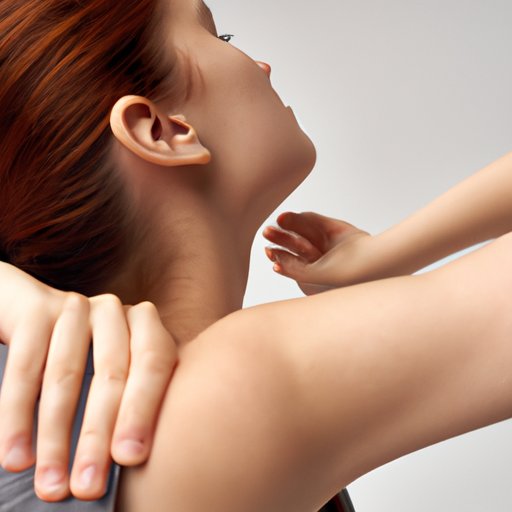Introduction
Body aches are a common problem for many people. They can be caused by a number of factors such as exercise, poor posture, stress, or underlying medical conditions. Whatever the reason may be, body aches can be incredibly frustrating and even debilitating. In this article, we will explore some effective approaches to relieve body aches and improve overall well-being.
Stretching
Stretching is an effective way to prevent the onset of body aches. It improves flexibility, increases circulation, and reduces muscle tension. Before any exercise routine or activity, it is important to properly stretch in order to prepare the muscles and reduce the risk of injury.
To stretch properly, begin by warming up with a few minutes of light activity. Then gently stretch each muscle group, holding each stretch for 10 to 30 seconds. Avoid overstretching as it can cause injury. Some common stretches include:
- Neck rolls: Gently roll your neck in a circular motion to stretch the neck muscles.
- Shoulder stretch: Place one arm across your chest and gently pull it with the other arm to stretch the shoulder muscles.
- Lower back stretch: Sit on the floor with your legs straight out in front of you. Slowly reach forward, bending at the hips, and try to touch your toes.
- Hip stretch: Lie on your back with your knees bent. Cross your ankle over your opposite thigh and gently pull your legs toward your body.
- Leg stretch: Sit on the floor with your legs straight out in front of you. Reach forward and try to touch your toes.
Massage
Regular massages can help alleviate chronic body aches. A massage therapist can help identify areas of tension and apply techniques to relieve pain and soreness. However, self-massage can also be beneficial, and it can be done at home with simple tools like tennis balls or a foam roller.
For areas such as the neck, shoulders, and back, try using a tennis ball to apply pressure to the sore muscles. Simply place the ball against a wall and lean your body into it, rolling the ball over the affected area. For the legs, a foam roller can be used to apply gentle pressure and relieve tension.
Professional massage options include techniques such as Swedish massage, deep tissue massage, or myofascial release. Each technique has its own benefits and is suited for different types of pain.
Heat Therapy
Heat therapy is a simple and effective way to alleviate body aches. Heat can increase circulation and relax tense muscles, which can reduce pain and stiffness. There are several methods of heat therapy, including:
- Heating pads: Apply a heating pad to the affected area for 20-30 minutes at a time.
- Warm baths: Take a warm bath with Epsom salts to help relax muscles and relieve pain.
- Hot towels: Soak a towel in hot water and apply it to the affected area.
- Hot stones: Hot stones can be used in massages to apply comforting heat to muscles.
It is important to use heat therapy carefully and follow safe practices. Avoid direct contact with heating pads or hot towels, and never fall asleep with a heating pad on your body.
Cold Therapy
Cold therapy can be useful for reducing swelling and inflammation. It also helps to numb the affected area, which can reduce pain. Cold therapy should be used for acute injuries such as sprains, strains, or bruises.
To apply cold therapy, use an ice pack or a cold compress that has been wrapped in a towel, and apply it to the affected area for 20 minutes at a time. Do not apply ice directly to the skin, as this can cause frostbite.
It is important to know when to use cold therapy versus heat therapy. For chronic pain such as arthritis, heat therapy may be more effective. However, for acute injuries such as a sprain, cold therapy may be more effective in reducing swelling and pain.
Exercise
Regular exercise can help reduce body aches by improving flexibility, strength, and stamina. Low-impact exercises such as yoga, Pilates, swimming, and walking are gentle on the body and can be a good starting point for those experiencing pain. These exercises can help loosen up stiff muscles and joints and promote relaxation.
When starting a new exercise regimen, it is important to start slowly and listen to your body. If you experience pain or discomfort, reduce the intensity or stop the activity altogether.
Diet
Diet can play a significant role in the onset and management of body aches. Eating foods that are high in anti-inflammatory properties can help reduce pain and inflammation. Foods such as fruits, vegetables, whole grains, lean protein, and healthy fats are excellent choices. On the other hand, processed foods, refined sugars, and alcohol should be avoided, as they can contribute to inflammation and pain.
Conclusion
Body aches can be frustrating and even debilitating. However, there are several approaches to relieving pain and promoting overall well-being. Stretching, massage, heat and cold therapy, exercise, and diet are all effective methods of reducing body aches. It is important to remember to start slowly, listen to your body, and seek medical help if pain persists.
